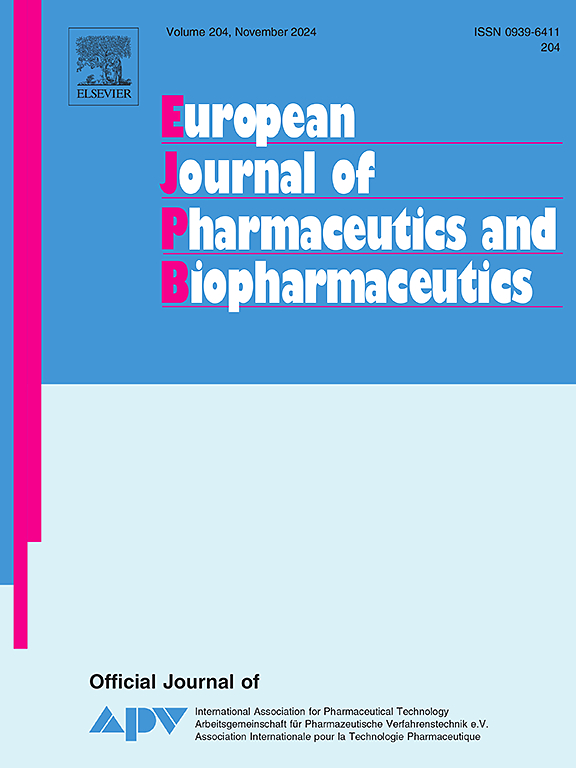A modern strategy for digital real-time release testing in continuous tablet manufacturing
IF 4.4
2区 医学
Q1 PHARMACOLOGY & PHARMACY
European Journal of Pharmaceutics and Biopharmaceutics
Pub Date : 2025-03-24
DOI:10.1016/j.ejpb.2025.114700
引用次数: 0
Abstract
The pharmaceutical industry is currently moving away from traditional approaches to quality control with off-line quality tests, limited in-line process monitoring and minimal control strategies towards more sophisticated methods. This transition addresses several critical aspects, including the reduction of ecological and economic footprints and ensuring the safety for patients and personnel. In that context, the initial step is the application of process monitoring tools, such as process analytical technology (PAT) and soft sensors, for real-time product quality assessment. This will enable real-time release testing (RTRT), which redefines conventional approaches by relying solely on the process data reported by equipment or collected from sensors to predict the product quality. However, the implementation of RTRT requires reliable material tracking algorithms, which align the process data with the product’s characteristics.
This study proposes a modern digital RTRT strategy that aligns process data collected from a state-of-the-art manufacturing line with a sophisticated process monitoring strategy for specific product quantities, i.e., single dosage units (tablets). To trace the material through the production line and align it to the collected process data, residence time distribution (RTD) models and material tracking algorithms were developed. The digital RTRT strategy was designed and demonstrated using the industrial manufacturing line ConsiGmaTM-25. The developed strategy makes full product quality information digitally available, including critical quality attributes (CQAs) and processing conditions experienced during the production. The obtained results were validated using traditionally established off-line methods.

片剂连续生产中数字实时释放测试的现代策略。
制药行业目前正在从传统的质量控制方法(离线质量检测、有限的在线过程监测和最低限度的控制策略)转向更复杂的方法。这一转变涉及几个关键方面,包括减少生态和经济足迹以及确保患者和工作人员的安全。在这种情况下,第一步是应用过程监控工具,例如过程分析技术(PAT)和软传感器,用于实时产品质量评估。这将使实时释放测试(RTRT)成为可能,它重新定义了传统的方法,仅仅依靠设备报告的过程数据或从传感器收集的数据来预测产品质量。然而,RTRT的实施需要可靠的材料跟踪算法,使工艺数据与产品特性保持一致。本研究提出了一种现代数字RTRT策略,该策略将从最先进的生产线收集的工艺数据与针对特定产品数量(即单剂量单位(片剂))的复杂工艺监控策略相结合。为了通过生产线跟踪材料并将其与收集的过程数据对齐,开发了停留时间分布(RTD)模型和材料跟踪算法。使用工业生产线ConsiGmaTM-25设计并演示了数字RTRT策略。开发的策略使完整的产品质量信息数字化可用,包括关键质量属性(cqa)和生产过程中经历的加工条件。使用传统的离线方法验证了所得结果。
本文章由计算机程序翻译,如有差异,请以英文原文为准。
求助全文
约1分钟内获得全文
求助全文
来源期刊
CiteScore
8.80
自引率
4.10%
发文量
211
审稿时长
36 days
期刊介绍:
The European Journal of Pharmaceutics and Biopharmaceutics provides a medium for the publication of novel, innovative and hypothesis-driven research from the areas of Pharmaceutics and Biopharmaceutics.
Topics covered include for example:
Design and development of drug delivery systems for pharmaceuticals and biopharmaceuticals (small molecules, proteins, nucleic acids)
Aspects of manufacturing process design
Biomedical aspects of drug product design
Strategies and formulations for controlled drug transport across biological barriers
Physicochemical aspects of drug product development
Novel excipients for drug product design
Drug delivery and controlled release systems for systemic and local applications
Nanomaterials for therapeutic and diagnostic purposes
Advanced therapy medicinal products
Medical devices supporting a distinct pharmacological effect.

 求助内容:
求助内容: 应助结果提醒方式:
应助结果提醒方式:


